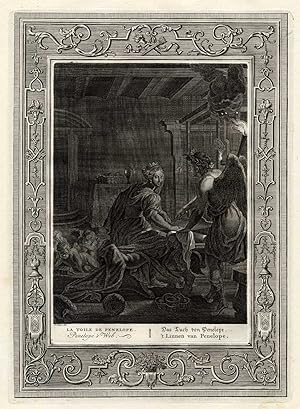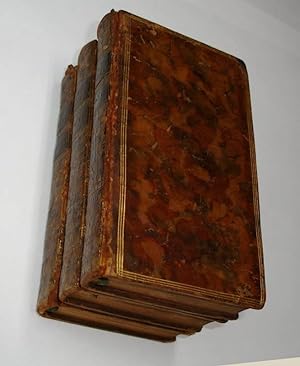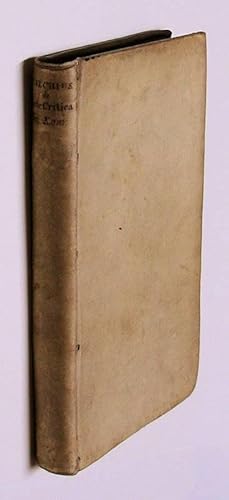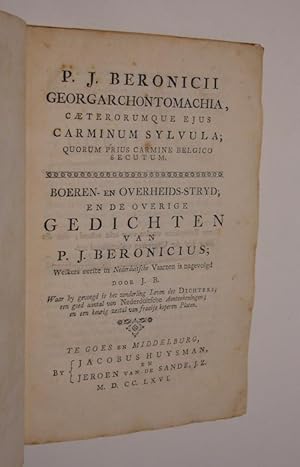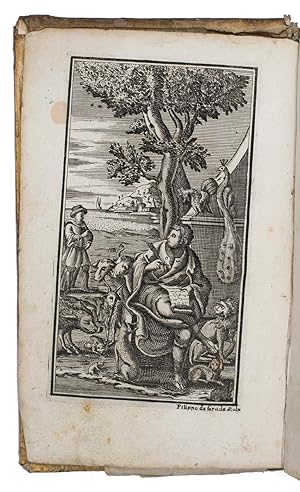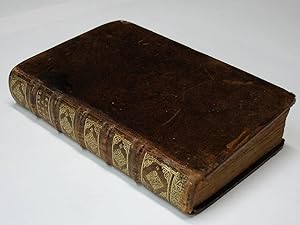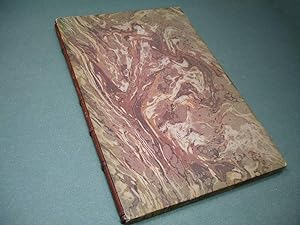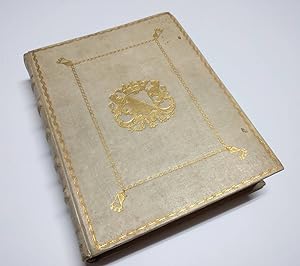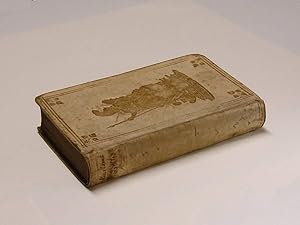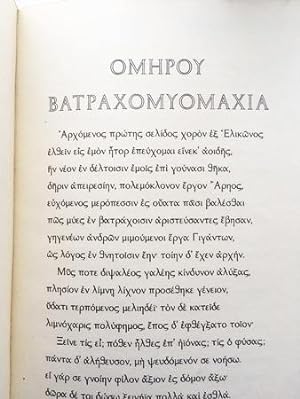(88 results)
Product Type
- All Product Types
- Books (81)
- Magazines & Periodicals
- Comics
- Sheet Music
- Art, Prints & Posters (7)
- Photographs
- Maps
-
Manuscripts &
Paper Collectibles
Condition
- All Conditions
- New
- Used
Binding
Collectible Attributes
- First Edition (5)
- Signed (1)
- Dust Jacket (15)
- Seller-Supplied Images
- Not Printed On Demand
Seller Location
Seller Rating
-
Homer the Theologian: Neoplatonist Allegorical Reading and the Growth of the Epic Tradition
Published by University of California Press, Berkeley, 1989
Seller: Bij tij en ontij ..., Kloosterburen, NL, Netherlands
Paperback, 23 cm, 363 pp. Cond.: zeer goed / very good. ISBN: 0520066227.
-
Seurat and the Science of Painting
Published by Cambridge : The M.I.T. Press, 1970
ISBN 10: 0262580365ISBN 13: 9780262580366
Seller: Klondyke, Almere, Netherlands
Book
Condition: Good. 2nd Edition. Original wrappers, illustrations in b/w, 8vo.; Crease in spine; corner frontcover and first pages slightly folded; few small stains on back cover.
-
Antique Print-PORTRAIT-HOMERUS-HOMER-Lavater-1781
Seller: ThePrintsCollector, Zeeland, Netherlands
Art / Print / Poster
Plate 9: Decorative sculptured portrait of Homerus / Homer. Original etching and stipple engraving on verge type hand laid paper with watermark. (Not visible on every sheet.) Description: This attractive original old antique print / plate originates from: 'Over de Physiognomie.', by J.C. Lavater, Dutch edition 1780-1784, translated from German by Johan W. van Haar and published by Johannes Allart in Amsterdam. The original German edition had appeared also in 4 vols. under the title 'Physiognomische Fragmente zur Beförderung der Menschenkenntnis und Menschenliebe.', Leipzig, 1775-1778. Lavater advocated the phenomenon of physiognomy, by which one could judge character from facial characteristics. Lavater claimed for instance that heavy brows grown together meant criminality; while a sloping forehead might show that one was less smart. The work had an very large impact hroughout Europe and as Lavater's ideas spread, people naturally wanted to have more professional and accurate depictions of other people and themselves, making the art of the silhouette portrait very popular.Artists and Engravers: Author: The Swiss theologian and mystic Johann Kaspar Lavater (1741-1801). The plates are engraved or etched by several artists, such as Heidegger from Zürich, Eckardt, Fresinger, I. Hegi and R. Brichet. Many plates in the text are engraved by the artists J.R. Schellenberg and J.H Lips. Johann Rudolph Schellenberg (1740-1806) was a Swiss painter, engraver and illustrator and entomologist. He is considered one of the greatest illustrators of his time and the most important Swiss engraver of the 18th Century. Johann Heinrich Lips (1758-1817) was a Swiss engraver. Condition: Excellent. General age related toning as visible on image. Some damp staining in top left corner of sheet not nearly effecting image or plate. Storage location: C79-13 The overall size is ca. 5.3 x 8.5 inch. The image size is ca. 3.5 x 5.5 inch. The overall size is ca. 13.5 x 21.5 cm. The image size is ca. 9 x 14 cm.
-
Abbeville Press, 1992. 34 x 29 cm. Hardcover (clothbound) with dustjacket. With illustrations in color and b/w. 276 pages. FINE COPY [ Art / international artist ].
-
Homer - Der Mythos von Troia in Dichtung und Kunst
Published by Hirmer, München, 2008
ISBN 10: 3777439657ISBN 13: 9783777439655
Seller: Antiquariaat Coriovallum, Heerlen, Netherlands
Book
Condition: as new. hardcover - wie neu - vrijwel NIEUWSTAAT - 506 pp.
-
Land of Dreams. Greek and Latin Studies in Honour of A.H.M. Kessels.
Published by Leiden, Boston, Brill, 2006., 2006
ISBN 10: 9004150617ISBN 13: 9789004150614
Book
Orig. pict. boards (hardcover) xxiv,416 pp.: portr.; 25 cm. Mainly in English, also German. As new, price when new EUR 99,00. This collection of essays by twenty-eight Dutch scholars is intended as a tribute to prof. dr. A.H.M. Kessels on the occasion of his retirement as professor of Greek Language and Literature at the Radboud University Nijmegen (Netherlands). It reflects his broad interests in the entire field of classical scholarship, ranging from early Greek poetry to later Latin literature and the reception of classics in modern literature. At the same time, the volume singles out some areas for special interest, notably dreams in classical literature (6 essays), classical drama (7 essays), the reception of Homer (4 essays), Greek literature (5 essays) and Latin literature (6 essays). The collection as a whole may be considered a sampler attesting the breadth and depth of present-day classical scholarship in the Netherlands. - 'info from Brill.nl' 1080g.
-
Antique Print-FRONTISPIECE-CLASSICAL HISTORY-AUTHORS-Lens-Sturt-ca. 1710
Seller: ThePrintsCollector, Zeeland, Netherlands
Art / Print / Poster
Antique print, titled: 'Dionysioy [.].' - Fama surrounded by famous classical authors: Demosthenes, Homer, Thucydides,Herodotus, Hegesias, Duris and Epicurus. Engraving on laid paper. Description: Frontispiece to an unidentified book.Artists and Engravers: Made by 'John Sturt' after 'Bernard Lens'. John Sturt (1658-1730) was active as writing engraver. He was a pupil of White. Bernard Lens II (1659-1725) was active draughtsman and mezzotinter. Condition: Good, given age. No margins. General age-related toning and/or occasional minor defects from handling. Please study scan carefully. Storage location: TPCRC-C12-14 The overall size is ca. 3.9 x 6.2 inch. The image size is ca. 3.9 x 6.2 inch. The overall size is ca. 9.8 x 15.7 cm. The image size is ca. 9.8 x 15.7 cm.
-
Etching and engraving of Epo Boetius (1529 - 1599), Dutch jurist/lawyer. 250 mm x 200 mm, in good condition, broad margins. Above the text on the left the signature "De L'armessin, scul".Boetius Epo (1529 November 16, 1599) was a lawyer and scholar from the Low Countries. He was born at Reduzum, in Friesland, in 1529. He studied at Cologne and Leuven, and made such rapid progress in the acquisition of the learned languages, that at the age of twenty he gave public lectures on Homer. He afterwards taught, not only at Leuven but at Paris, jurisprudence, the belles-lettres, and theology, and afterwards went to Geneva with a view to inquire if the religious principles of John Calvin were worthy of the reputation they had gained. Not satisfied, however, with them, Boetius Epo returned to the Catholic Church in which he had been educated, and confining his studies to the Civil Law and Canon Law, took the degree of doctor in 1561, at Toulouse. He then returned to Leuven, where he lectured until he was chosen one of the professors of the new University of Douai, an office which he held for twenty-seven years. He died November 16, 1599.] He wrote many works on law and ecclesiastical history.Fries jurist - Homerus - Calvijn - Katholieke kerk - historicus - jurist Etching and engraving of Epo Boetius (1529 - 1599), Dutch jurist/lawyer. 250 mm x 200 mm, in good condition, broad margins.
-
British Image 1
Published by The Arts Council of Great Britain, 1975
ISBN 10: 0728700352ISBN 13: 9780728700352
Seller: Klondyke, Almere, Netherlands
Book
Condition: Good. Original wrappers, softcover, illustrated with (full page) b/w photographs, small 4to.; Slightly foxed on top cut; small wrinkle edge front cover.
-
Antique Print-ACHILLES-LYRE-MUSICIAN-PORTRAIT-Plate 151-Worlidge-1768
Seller: ThePrintsCollector, Zeeland, Netherlands
Art / Print / Poster
Original finely engraved print, from a scarse and beautifully executed collection of images, strong impressions. Plate no. 151, captioned: 'Achilles'. It shows a full-length portrait of Achilles playing the lyre. He is portrayed with several of his trappings, such as his shield, helmet and club. Achilles was taught to play the lyre by Chiron the Centaur. He would play an important role in Homer's Ilias. Very finely etched lines and tones (possibly some mezzotint or drypoint created tones) on a verge type hand laid paper. Description: This scarse print / plate originates from: 'A Select Collection of Drawings From Curious Antique Gems; Most of Them in the Possession of the Nobility and Gentry of This Kingdom; Etched After the Manner of Rembrandt.', by T. Worlidge, painter, published in London, 1768. Worlidge's last work was this Antique Gems, a series of 182 etchings of gems from the antique (three are in duplicate). The series was published in parts, some of which seem to have been issued as early as 1754; but Worlidge died before the work was completed. It was finished by his pupils William Grimaldi and George Powle.Artists and Engravers: Engraver and artist: T. Worlidge: Thomas Worlidge (1700-1766) was an English portrait painter and etcher. He studied art in London as a pupil of the Genoese refugee Alessandro Maria Grimaldi (1659?1732). He painted portraits of his master Grimaldi and his master's wife about 1720. He married Grimaldi's daughter, and remained on close terms with Alexander Grimaldi, his master's son. Subsequently he received instruction from Louis Peter Boitard. Condition: Excellent given age. Browned from aging in the right margin. General age related toning and some occasional light staining or thumbing or faint foxing. Please study scan carefully. Storage location: C231-12 The overall size is ca. 8.5 x 11.6 inch. The image size is ca. 4 x 3 inch. The overall size is ca. 21.5 x 29.5 cm. The image size is ca. 10.2 x 7.7 cm.
-
Antique title page | Allegorical composition, published 1711, 1 p.
Seller: Antiquariaat Arine van der Steur / ILAB, Den Haag, Netherlands
Personification of Heroic Poetry leading a Spirit who is carrying the works of Homer, to the Temple of Memory, whose doors are being opened by Mnemosyne; Envy, who sits at the entrance of the Temple, tries to prevent the Spirit to enter it; two putti and Time are hanging a portrait of Homer above the entrance, while Fame blows her trumpet.Frontispiece to 'L'Iliade d'Homère traduite en françois', a French translation of the Iliad, by Madame Dacier (Paris: Rigaud, 1711).Signed at bottom: B. Picart jn. et fecit. 1711.[NL] De personificatie van de Heroïsche Poëzie leidt een jongen, die het genie van Homerus symboliseert, naar de tempel van de herinnering. Afgunst (Invidia) probeert hen tegen te houden. Mnemosyne, de godin van het geheugen, opent de deuren van de tempel. Vader Tijd hangt een portretmediallon van Homerus boven de ingang. In de lucht Faam (Fama) die de bazuin blaast. In de marge een vijfregelig onderschrift in het Frans. Etching on paper; total: 150 x 94 mm; a repaired hole on the verso, otherwise in good condition.
-
Inleiding in de fabelkunde der oude Grieken en Romeinen, door Christiaan Tobias Damm, rector van het Koninglyk Gymnasium te Berlin. Naar den vyfden druk uit het Hoogduitsch vertaald.
Published by Leiden (Leyden), By W.H. Gryp, 1786., 1786
Seller: Antiquariaat Fragmenta Selecta, AMSTERDAM, Netherlands
8vo. (II),VIII,348,(XX) p. Half calf 16 cm (Details: Back ruled gilt. Marbled endpapers) (Condition: Binding scuffed, back rubbed, corners bumped. Stamp on front flyleaf, 3 stamps on the title) (Note: Christian Tobias Damm, 1699-1778, 'Rector am köllnischen Gymnasium zu Berlin', 'im grauen Kloster' in the 'Klosterstrasse' was a solid classicist, and one of the first German scholars who stressed the excellence of Greek literature and its language compared to Roman literature and language. He also stressed the necessity of imitating the Greek examples for the improvement of national education. He wanted to make the masterpieces of Greek poetry accessable for a general public with litteral and trusty translations. He produced a Lexicon Pindaricum, and Novem lexicon Graecum etymologicum et reale, cui pro basi substratae sunt concordantiae et elucidationes homericae et Pindaricae. (Berlin, 1765) He also made a much criticized translation of Homer. One critic accused him of having murdered Homer. He had more success with his manual of Greek and Roman mythology: 'Einleitung in die Götterlehre und Fabelgeschichte der ältesten griechischen und römischen Welt'. (Berlin 1763) (Allgemeine Deutsche Biographie 4 (1876), p. 718) This manual remained in use in Germany well into the 19th century, and was translated into Dutch and Norwegian. The manual was reissued several times in Holland. The Dutch publisher of this 1786 edition misunderstood 'Köllnisches Gymnasium' and had 'Koninglyk' (Royal), printed on the title page) (Collation: pi1, *4, A-Z8, 2A2) (Photographs on request) 300 gr.
-
Homers Iliade. Erklärt von J. U. Faesi, I-IV. Gesang I-XXIV. Sammlung griechischer und lateinischer Schriftsteller mit deutschen Anmerkungen. [FOUR VOLUMES].
Published by Berlin, Weidmann, 1871-77., 1871
Seller: Librarium of The Hague, The Hague, Netherlands
Book
Hardcover. Condition: . ~ [TEMPORARY REDUCTION SALE: 20-30% OFF THE REGULAR PRICE] ~ (illustrator). Four volumes. Crown octavo. Volume I: Gesang I-VI. Pp. xxxv, 234; Volume II: Gesang VII-XII. Pp. 212; Volume III: Gesang XIII-XVIII. Pp. 260; Volume IV: Gesang XVII-XXIV. Pp. 238. HARDCOVER, uniformly bound in contemporary cloth and marbled boards with the original printed front wrapper of each volume laid-down. In a very good condition. Clean and neat set, very well preserved. ~ Fifth edition. 001-2.
-
Homer Ilias. Für den Schulgebrauch erklãrt .( 8 vols set)
Published by Adolf Hakkert, Amsterdam, 1965
Seller: Otia antiquariaat, The Hague, Netherlands
Book First Edition
Hardcover. Condition: Very Good. Dust Jacket Condition: Very Good. 1st Edition. 8 vols set. Cloth binding. Books as well as binding are in very good condition. Clean pages without notes, marks, stamps nor underlining.
-
Antique Print-HOMER-FRIEZE-CELEBRATION-APOTHEOSIS-Diderot-Benard-1751
Publication Date: 1751
Seller: Pictura Prints, Art & Books, Overasselt, Netherlands
Art / Print / Poster
Copperplate engraving and etching on hand laid (verge) paper. on paper. Size in cm: The overall size is ca. 25.3 x 39.2 cm. The image size is ca. 23 x 34 cm. Size in inch: The overall size is ca. 10 x 15.4 inch. The image size is ca. 9.1 x 13.4 inch.Antique print, titled: 'Antiquities, Apotheose d' Homere' - Apotheosis of Homer. Engraving of a frieze celebrating Homer. "Encyclopedie ou Dictionnaire raisonne des sciences, des arts et des metiers, par une Societe de Gens de lettres.' which was published under the direction of Diderot and d'Alembert, with 17 volumes of text and 11 volumes of plates between 1751 and 1772. It contained 72,000 articles written by more than 140 contributors. This encyclopdia was a massive reference work for the arts and sciences, as well as a means to propagate the ideas of the French Enlightment. The impact of this encyclopedia was enormous. Artists and Engravers: Made by 'Diderot' after 'Bernard'. Denis Diderot (1713-1784) was a French philosopher, art critic and writer. Jean le Rond d'Alembert (1717-1783) was a French mathematician, mechanician, physicist and philosopher. These plates are engraved by J.A.Defehrt and Bonaventure/Benoit-Louis Prevost after J.R Lucotte or Goussier.Condition: Excellent, given age. Excellent. General age related toning. Occasional light staining. Stain in lower right. General age-related toning and/or occasional minor defects from handling. Please study scan carefully.Keywords: ANTIQUE PRINT-HOMER-FRIEZE-CELEBRATION-APOTHEOSIS-DIDEROT-BENARD(PCOMAN) A109-23.
-
London, Methuen, 1967. (XVII) 460, (XIV) 637 pp. Cloth + dustjacket. Portrait. Illustrations. (The poems of Alexander Pope. Translations of Homer, 9, 10) *library sticker on dustjackets, spines and endpapers, library stamp verso title pages, dustjackets a bit damaged, otherwise in good condition* The Twickenham edition of the poems of Alexander Pope. Index in the second volume.
-
Pindari carmina. Ex editione Chr. Gottl. Heyne.
Published by Oxford (Oxonii), Typis N. Bliss, impensis M. Bliss et R. Bliss, 1808., 1808
Seller: Antiquariaat Fragmenta Selecta, AMSTERDAM, Netherlands
16º 2 volumes in 1: (IV), 230,(2 blank);138,(2 blank) p Black morocco 12 cm (Ref: Hoffmann 3,100: 'Schöne Ausgabe'; Schweiger I,236; Brunet 4,660; Graesse 5,295; Ebert 16880; Not in Gerber; Rico, Ensayo de bibliografia Pindarica, p. 3) (Details: Back gilt and with 3 raised bands. Boards with double fillet gilt borders. Within these borders a band of blind-stamped floral motives. Edges of the boards and of the book-block gilt. Gilt inside dentelles. Charming and fine typography. The odes are preceded by explanatory 'argumenta'. There is no Latin translation, nor commentary) (Condition: Wear to the extremes of the binding. Ownership inscription on the front flyleaf) (Note: A quarter of the works of the Greek poet Pindar, ca. 518-438 B.C., his four books of epinicia, named after the Great Games, the Olympian, Pythian, Nemean and Isthmian, survive. Pindar wrote eulogistic hymns to celebrate a victory in athletics, boxing and horse racing. Praised in a magnificent way are the victor, his family, the native city. 'Each ode draws from a variety of historical, cultural, and mythological sources. The highly allusive manner by which this material is presented is complemented by an equally rich repertoire of metrical patterns from epic, Doric, and Aeolic systems'. (The Classical tradition, Cambridge Mass., 2010, p. 729) 'Extended similes and difficult metaphors, intricate syntax and rapid narration, far-reaching digressions and bold disruptions' result in grandiose, but also enigmatic poetry. § Pindar's influence on European literature is great. The great number of editions and translations of Pindar's odes that were printed in the 16th century are an indication of a widespread humanist interest. Pindar was, with the Roman poet Horace, the chief classical model for modern formal lyric poetry. The poets of the Renaissance borrowed first of all thematic material from Pindar. 'They enriched their language on the model of Pindar's and Horace's odes, taking it father away from plain prose and from conventional folk-song phraseology. And in their eagerness to rival the classics, they made their own lyrics more dignified, less colloquial and song-like (.) more ceremonial and hymn-like'. (G. Highet, 'The classical tradition', Oxford 1978, p. 230) § Many of Pindar's maximes and punctuated statements, containing elements of traditional wisdom, were collected in Renaissance anthologies of 'sententiae'. 'Pindar (.) provided the Humanists of the Reformation with pithy statements of moral instruction and wordly advice, which ensured the poet's place in pedagogical circles. Moreover, as a source of proverbial wisdom, Pindar was elevated nearly to the status of biblical Salomon. (.) The sheer variety of Pindarically influenced traditions -the political ode and the personal, the religious hymn and the song of genius, the freely aimless and the rigorously concise- all serve as a testament not only to Pindar's versatility, but also to his rich potential to inspire'. (The Classical tradition, Cambridge Mass., 2010, p.729/30) § The German classical scholar Christian Gottlob Heyne, 1729-1812, was, according to Sandys, not an original genius. 'He was a many-sided scholar, who studied and expounded ancient life in all its successive phases, and became the founder of that branch of classical teaching that deals with the study of Realien'. (Sandys 3, p.40) The criticism and exposition of ancient poetry is represented in his still important editions of Tibullus, Vergil, Pindar and the Iliad of Homer. His textual criticism is weak. 'His choice among different readings is guided more by personal preference than by an impartial weighing of the evidence'. (.) The preparation of the metrical part of his Pindar was entirely entrusted to Hermann, then 25 year of age. Heyne's own interest lay, not in the metre, but in the subject-matter of the Odes'. (Idem, ibidem)) (Provenance: On the front flyleaf: 'Louis LeBrun, from his sincere friend W.L., 11 Mars 1859') (Collation: pi2, B-P8, Q4 (leaf Q4 blank); pi2, B-I8, K4 (leaf K4 blank)) (Photographs on request) 300 gr.
-
De kleine Telemachus, of kort begrip van de lotgevallen van Telemachus, zoon van Ulysses [Homer]
Seller: Goltzius, Lisse, Netherlands
Ath [Wallonia], P. J. Themon, drukker en boekverkooper; en E. Jouret-Themon, 1823. [3] 251. Rare schoolbook on the adventures of Telemach, translated from the french, with a dictionary dutch/french. Half-leather, marbled boards (slightly worn). damaged last endpaper revealing the cardboard on the inside of the cover. Tear in pag. 244-245 carefully repaired.
-
Homers Odyssee von Johann Heinrich Voss I-XXIV gesang Dritte verbesserte auflage.
Published by J.G. Cotta'schen Buchhandlung, Tübingen, 1806
Seller: Antiquariaat Meuzelaar, Heusden, NB, Netherlands
Book
Contemporary Half Leather. Condition: 8 (1-10). Place Printed: Tübingen 2 No of BindingsPart 1: 2 Blank pages / 1 Blank pages / 5 Blank pages / 270 Pages / 1 Folding maps Part 2: 2 Blank pages / 1 Blank pages / 1 Blank pages / 260 Pages / 2 NNP / 1 Engraved Plates / 1 Maps There are 5 extra pictures availabe on request! Height (cm): 20,3 Width (cm): 13 Thickness (cm): 4,2 Weight (kg): 0,61.
-
Antique Mythology Print-PENELOPES WEB-OVID-Picart-1733
Publication Date: 1733
Seller: Pictura Prints, Art & Books, Overasselt, Netherlands
Art / Print / Poster First Edition
Original etching and engraving combination on a verge type hand laid paper. 100% original and authentic. on paper. Size in cm: The overall size is ca. 31.5 x 49 cm. The image size is ca. 24.5 x 34.5 cm. Size in inch: The overall size is ca. 12.4 x 19.3 inch. The image size is ca. 9.6 x 13.6 inch.Plate: ' Penelope's Web.' (Plate is accompanied by text in French, English, German and Dutch under image.) Penelope, Queen of Ithaca, was the wife of Ulysses. In Homer's, Odyssey, she became the symbol of all domestic virtues, most notably, faithfulness. The long absence of her husband and reports of his possible death prompted many ambitious suitors to the palace at Ithaca. To buy time, Penelope promised to select one of them as her new husband and king as soon as she had finished weaving a shroud for her father-in-law. Every night she unraveled the work she had done during the day. This was the 'web of Penelope'. This attractive original old antique print / plate originates from: 'Tafereel, of Beschryving van den prachtigen Tempel der Zang-Godinnen.' (Translation from Dutch: Scene or description of the magnificent temple of singing godesses.), by Bernard Picart Le Romain and published by H. Chatelain in Amsterdam, 1733. This is the first edition of this beautiful work, which took three years to complete, is a highlight of 18th century Dutch book illustration. The work consists of 60 full-page folio size plates within different ornamental borders, illustrating the Metamorphoses by Ovidius. Artists and Engravers: The author and engraver of this work is Bernard Picart (1673-1733). He was a French painter and engraver. He received his art education from his father, Etienne (1632-1721), from Le Brun and Jouvenet at the Royal Academy. His talents developed rapidly: at the age of sixteen he gained honors at the Academy of Paris.He was born in Paris and died in Amsterdam. Other engravers worked on this work as well.Condition: Fine. General age related toning.Keywords: ANTIQUE MYTHOLOGY PRINT-PENELOPES WEB-OVID-PICARTPCOX-E1-14.
-
C. Corneli Taciti Quae exstant opera. Recensuit J.N. Lallemand.
Published by Paris (Parisiis), Apud Desaint & Saillant, (.) typis J. Barbou, 1760., 1760
Seller: Antiquariaat Fragmenta Selecta, AMSTERDAM, Netherlands
12mo. 3 volumes: XXIV,444; (VI),480; 456 p., 3 frontispieces. Mottled calf. 16 cm (Ref: Schweiger 2,1004: 'L.'s Noten sind von Werth'; Dibdin 2,455: 'one of the most beautiful and correct of all his classics'; Moss 2,645: 'A pleasing and accurate little edition'; Graesse 6/2,10: 'Jolie edition dans laquelle le texte d'Ernesti (of 1752) a ete corrigé à l'aide d'un manuscript de Paris'; Ebert 22175; Brunet 5,636: 'Bon texte') (Details: Backs with 2 shields, and gilt with fleurettes. Edges of the boards and the bookblocks also gilt. Boards with triple fillet gilt borders. Marbled endpapers. The frontispiece of the first volume, designed by Ch. Eisen and executed by L. Lempereur depicts Tacitus in his study; Tacitus looks at a bust of Agricola, his father in law. The second frontispiece depicts Messalina, the wife of the emperor Claudius; the third Galba. Barbou's woodcut printer's mark on the three titles, depicting an old man who stands in the shade of a vine-entwined elmtree, symbolising the symbiotic relationship between scholar and publisher. The motto is: 'Non solus'. Three nice engravings in the text) (Condition: Bindings scuffed, especially at the extremities. Corners bumped. Two joints are splitting. Front joint of volume three is cracking. Old ink inscription on the front flyleaf of volume one) (Note: The Roman historian Publius Cornelius Tacitus offered ammunition for many intellectual and political battles in 16th and 17th century Europe. The turmoil caused by the emerging new monarchies in England, France en Spain, civil and religious wars in Italy and Germany, and the plague, made Tacitus' account of the state of the early Roman Empire increasingly topical and relevant. The debate Tacitus provoked in intellectual circles was of course on Roman history, but also on literary style, in Latin and the vernacular, but more so on historical and political thought. Tacitus ideas were not original, but he brought them in a forceful lapidary way, oneliners ready for the use in debate. Tacitus became in a corrupted world 'the one true guide for those involved in the awful revolution of modern times: he "teaches well the mode of life under tyrants, just as he teaches tyrants how to establish tyranny'' '. (The Classical Tradition, Cambr. Mass., 2010, p. 921) The French humanist scholar Muretus (Marc Antoine Muret, 1526-1585) declared that 'Tacitus' descriptions of lost liberty, failed revolutions, vicious civil wars, and mad emperors amounted to a theater of our time'. (Op. cit., ibid.) The French encyclopedists of the 18th century 'turned Tacitus into an enlightened enemy of obscurantist princes. This is the Tacitus, wise and mild, who prevailed in Europe immediately before the French revolution'. (R. Ash editor, 'Tacitus', Oxford, 2012, p. 429) In the preface to this Tacitus edition of 1760 the French scholar Nicolas Lallemand acknowledges that he used for his work the editions of Lipsius, Ryckius, Ernesti, and especially the edition of J. Gronovius that was published in Leiden in 1721; he was advised, he tells, by Claudius Capperonerius, or Claude Capperonnier, custos of the Royal Library, and 'Regius linguae Graecae professor'. Lallemand's text contains the readings of some manuscripts of the Royal Library, especially of those which coincide with the 'editio princeps'. Worldcat records 20 reissues of Lallemand's edition between 1760 and 1832) (Provenance: On the front pastedown of all three volumes the armorial bookplate of G.C.J. Vosmaer. Gualtherus Carel Jacob Vosmaer, 1854 - 1916, was a Dutch zoologist. He was the son of the Dutch author Carel Vosmaer, who produced a successful translation of Homer's Ilias and Odyssea) (Collation: pi1, a12, A-S12, T6; pi2, A-T12, V-X6; pi2, A-S12, T-V6) (Photographs on request) 1000 gr.
-
Io. Ernest. Imman. Walchii De arte critica veterum Romanorum liber. Editio secunda auctior et emendatior.
Published by Jena (Ienae), Sumtu Io. Christoph. Straussii, 1757., 1757
Seller: Antiquariaat Fragmenta Selecta, AMSTERDAM, Netherlands
8vo. (VIII),236,(11 index),(1 blank) p. Vellum 17.5 cm (Ref: VD18 10328696) (Details: Manuscript title on the back. Woodcut printer's mark on the title, with the initials J.C.S. on a baroque escutcheon that leans against a bush) (Condition: Vellum age-tanned. Small name on the front flyleaf. Paper yellowing) (Note: Johannes Ernst Immanuel Walch, 1725-1778, studied classical and semitic languages at the University of Jena, and also natural science and mathematics. In 1750 be was appointed professor extraordinarius of theology, and in 1755 he became professor ordinarius of logic and metaphysics. In 1759 he exchanged this chair for a professorship of rhetoric and poetry. His main interest as a classical scholar was the exegese of the New Testament. As was the custom of his time the professor Eloquentiae published a number of short 'programmata'. Noteworthy are his 3 volume 'In Acta Apostolorum Dissertationes' (1756, 1759, 1761), and his posthumously published Observationes in Matthaeum ex Graecis inscriptionibus (1779) In these works he tries to determine the meaning of the Greek of the New Testament, using profane sources and above all inscriptions.To promote the study of Greek philology he published in 1763 an Introductio in linguam graecam, a useful encyclopedia of Greek philology, which offered a survey of the sources of the Greek language and an outline of the history of Greek literature. § The book here on offer is announced on the title as second edition. Walch himself tells about the history of the 'first edition' in the preface. This first edition consisted, he tells, in reality of 3 dissertations on the 'ars critica', published between 1747 and 1750. The dissertations were defended by his students 'more academico', but were in reality written by himself. The first dissertation of 1747 Dissertatio de ortu et progressu artis criticae apud veteres romanos was defended by one Johannes Gottlieb Oleario. When Walch noticed that this dissertation met with some success he wrote in 1749 another dissertation on this subject, Diatribe de arte critica veterum romanorum', which was defended 'praeside M. Io. Ernesto Immanueli Walchio' by one Fridericus Fürchtenicht, and in 1750 one Johannes Fridericus Thauer defended Walch's Diatribe posterior de arte critica veterum romanorum. The second edition of 1757 is, he says, an updated adaptation and revision of these three dissertations. (Praefatio p. *4 recto & verso) In Lebensgeschichte des Joh. Ernst Immanuel Walch, Jena 1780, these 3 treatises are numbered among his own 'Akademische Disputationen'. Walch's De arte critica has been examined recently at an online platform of scholarly German publications, 'Fachpublikation' by Prof. Dr. Fee-Alexandra Haase: 'Kunst der Kritik (ars critica) ist in der Aufklärung eine Bezeichnung für eine Methode der Textbearbeitung in der Philologie und Grammatik. Der Begriff wird für die Bezeichnung der antiken Rhetorik bei der Darstellung von Quintilian und zur Beschreibung von Methoden und Formen von Texten zur Umschreibung des praktischen Anwendungsbereichs der Rhetorik in der Kritik von Kunst und Literatur in Staatsschriften eingesetzt. In diesen Schriften wird von Autoren nach den Disziplinen Philologie und Geschichtsschreibung ein Ideal von Kritikern dargestellt, die als Vertreter einer Kunst der Kritik (ars critica) Anteil an verschiedenen Disziplinen haben. Das Bild ist noch in Johann Ernst Immanuel Walchs Schrift De arte critica veterum Romanorum aus dem 17. Jahrhunderts durch die Übernahme von dessen Anweisungen zur Rednerausbildung in der Institutio Oratoria geprägt. Quintilian repräsentiert für Walch die Personalunion von Rhetoriker, Kritiker und Grammatiker und wird neben anderen Vertretern als ein Gewährsmann für Lehren in den Fächern Rhetorik, Dichtung und Kunst der Kritik (ars critica) herangezogen. Eine Gliederung dieser Kunst der Kritik (ars critica) in drei Disziplinen legt Walch zugrunde. So verwendet Walch die Dreiteilung von Kritik in die Bereiche der Anwendung in der Philosophie, Geschichte und Grammatik. Als Vertreter der Disziplinen aus der antiken Kunst der Kritik (ars critica) dienen ihm Homer, Aristoteles und die in platonischen Schriften dargestellten Personen Kratylos, Gorgias, Ion und Sokrates. Neben dieser Definition des Gegenstands für den Bereich der Kritik bestimmt er als philologische Aufgaben der Kunst der Kritik die Verbesserung (emendatio) von falschen Textstellen und die Auslegung (interpretatio) eines Textes. Als Bestandteile der Literaturkritik führt Walch das Wissen, richtig zu sprechen (recte loquendi scientia) und die dichterische Erzählung (narratio poetarum) an. Eine Aufgabe der Kritik (critica) ist die Deutung der Dichter (interpretatio poetarum). So bemerkt Walch, daß die Kritik zu den Aufgaben der Rhetorik gehört und Rhetoriker wie Dionysius Halicarnassus und Isokrates für die Leistungen der angewandten Methoden der Kritik beispielhaft sind. Für die Methode des rechtmäßigen Schreibens mit dem Begriff Verfahren des rechten Schreibens (recte scribendi ratio) beruft er sich auf Quintilian, der diese Fähigkeit als Quelle des Urteils mit dem Begriff Urteil (iudicium) betrachtet. Walch weist mittels des historischen Beispiels Quintilians darauf hin, daß der Kritiker (criticus) und der Grammatiker (grammaticus) identisch sein können. Als Beispiel dieser Personalunion dient ihm Quintilian, der nicht nur die Vorschriften für das gute Reden (bene dicendi), sondern auch die Methoden der Erregung von Affekten (ratio concitandorum affectuum) beherrschte. Als Arten und Gebrauch von Sentenzen (genera et usus sententiarum) werden die Erfindung (inventio propositionum) und die Art und Weise des Lesens und Nachahmens von Literatur (legendi atque imitandi modus) vermittelt. Ein Beispiel für die Anwendung einer Kunst der Kritik (ars critica) als philologische Kritik an Texten im 18. Jahrhundert ist Johannes Ernst Immanuel Walch. Einen Bereich der Anwendung von Kritik repräsentiert im Jahr.
-
P.J. Beronicii Georgarchontomachia, caeterorumque ejus carminum sylvula; quorum prius carmine belgico secutum. Boeren- en overheids-stryd, en de overige gedichten van P.J. Beronicius, welkers eerste in Nederduitsche vaarzen is nagevolgd door J.B. Waar by gevoegd is het zonderling leven des dichters; een goed aantal van Nederduitsche aanteekeningen; en een keurig zestal van fraaije koperen platen.
Published by Te Goes & Middelburg, Bij Jacobus Huysman & Jeroen van de Sande, J.z., 1766., 1766
Seller: Antiquariaat Fragmenta Selecta, AMSTERDAM, Netherlands
8vo. XX,178 p. Modern half vellum 22 cm (Ref: Best source: C.J. Krijger, 'P.J. Beronicius Boeren- en Overheidsstryd, 1673'. Doctoraal scriptie 1986, Reliable: Winkler Prins 6e dr., vol. 3, p. 777; also important: Sizoo, Hermeneus 8 (1936) p.17/21; uncritical: Van der AA 2,442/45; NNBW 8,88) (Details: Tasteful antique style binding, with a red morocco shield on the back. Frontispiece & six scenes on three plates by Simon Fokke. The frontispiece depicts the crowning with a laurel wreath by Apollo of a beggarly fellow, who wears ragged clothing. In the distance we see the townscape of Middelburg, in the front a pile of books and the attributes of a chimney sweep; on the plates scenes of armed and angry mobs. On the verso of the title the signature of one of the publishers J. Huysman. At the end have been added 22 pages with 'adnotationes ad Georgarchontomachiae librum 1 & 2' by Petrus Rabus, followed by 20 pages filled with annotations of J.B. in Dutch) (Condition: A light brown stain on the lower margin of 3 leaves) (Note: In 1672, on the 21st of july, a false rumour swept over the Dutch island of Walcheren: 'The French fleet is landing'. These were combustable times, called in Dutch 'het rampjaar' i.e. the year of disasters, when the Dutch Republic was besieged from all quarters. At this rumour a furious mob of armed farmers invaded Middelburg, the capital of the province of Zeeland. The mob assaulted and arrested city officials considered to be traitors. In the next year a mock epic concerning this historic event was published in Amsterdam 'auctore N. Autopte', i.e. by Mr. Eyewitness. In 1676 the remonstrant minister Anthony Borremans (who died in 1683), a man well versed in Greek and Latin, reported in the 6th chapter of his Variae Lectiones that the author was one Petrus Johannes Beronicius. He procured also a biographic sketch of this Beronicius which seems to be the starting point of a mystification. Borremans tells that he and some gentlemen (J. Antonides van der Goes, Dirk Buysero, Johan Frederik Gymnich) once ran in Middelburg into a pityful drunk, who composed Latin verse incredibly fast and on the spot. He was a man of loose morals, who earned his living sweeping chimneys and grinding knives. Nevertheless this dirty little fellow 'klein, roetzwart, rond en dik, oud en slordig gekleed', who also made strange gestures, was an accomplished neolatin poet. It was said that he spoke his Latin too fast even for the classical scholar J.F. Gronovius, when they met. He also spoke Greek fluently, and could speak judiciously and scholarly about classical authors. This wonder of the world had witnessed the revolt of the farmers, and, knowing his Homer very well, produced extempore a burlesque epic about the event, the Georgarchontomachia. In february 1673 this colourful drunk was found dead in a ditch. The classical scholar and neolatin poet Petrus Rabus, 1660-1702, published in 1691 an new edition of this satyrical follow-up of the Homeric Batrachomyomachia, accompanied by a translation into Dutch and annotations. He also followed the biography by Borremans. The Latin text was published and translated once again by one J.B. in 1766. J.B. also printed the biographic sketch of Borremans, and added 20 pages of notes in Dutch of his own. The biographic data of this versifying chimney sweep were reproduced indiscriminately in later biographic surveys, like Van der Aa, and NNBW. STCN suggests that Dirk Buysero, 1644-1708, a city official of the city of Vlissingen (Flushing), who was one of the men who met Beronicius, might be the real author. There is no evidence for this. It is even improbable. Buysero did not compose one syllable of neolatin poetry. Our guess is that it might be the scholar and soldier Joan van Broekhuizen (Janus Broukhusius), 1649-1707, who was an intimate friend of Buysero and Van der Goes, and was himself an accomplished neolatin poet, and a translator. Stylistic research is needed here. A problem is that the name of J.P. Beronicius is not an invention or concoction. There exists in the city accounts of Middelburg a record of someone bearing his name, for producing some occasional verses) (Collation: *8, 2*2, A-L8, M1) (Photographs on request) 0 gr.
-
[6], 256, [4] pp.One of the many early 18th-century Naples editions of the 94 Aesop fables in Latin verses with notes underneath, and the 5 additional fables found by the German philologist and classical scholar Marquart Gudius, together with the extended and scholarly notes and annotations, printed underneath each fable. Together with the 42 fables of Avianus in Latin verses without notes or annotations, the Greek texts of some fables of Aesop, and the Batrachomyomachia by Pseudo-Homer in alternating Greek and Latin lines. These texts are based on the recension by David van Hoogstraten (1658-1724), the conrector of the Latin School of Amsterdam (1694-1722). Apart from being a prolific Dutch and Neo-Latin poet, Van Hoogstraten was an esteemed linguist and philologist who edited a number of classical authors. The first edition of the Van Hoogstraten edition appeared in Amsterdam in 1701. Our edition is a page-for-page edition of the 1729 Naples edition by Felix Musca for Josephi Ponzelli, 1729 (see nr. 33).With ownership s entry of Nicolai del Rosso (dated 1745) on title-page, who also added his annotations, esp. on pp. 1-120. Rather stained and slightly browned copy. Spine half loose, vellum soiled and wrinkled.l Cf. Bodemann, 94.1.
-
L'Iliade. Poëme, avec un discours sur Homère. Par Monsieur De la Motte, de l'Académie Françoise.
Published by Paris, Chez Gregoire Dupuis, 1714., 1714
Seller: Antiquariaat Fragmenta Selecta, AMSTERDAM, Netherlands
8vo. Frontispiece, CLXXX,208,16,(8) p.; 12 full-page engravings. Contemporary calf 17 cm (Ref: Hoffmann 2,345; Cioranescu 36534; Graesse 3,337; Ebert 100600) (Details: Decorated gilt back with 5 raised bands. The frontispiece and engraved plates depict scenes from the Ilias; they were designed by Fr. Roettiers, Nattier, A. Dieu, & F. Delamonce, and executed by Edelinck & Chaufourier. Woodcut head-pieces) (Condition: Binding scuffed, corners bumped. Leather of the turn-in of the lower board partly worn away. Flyleaves removed. A tiny strip of a few millimeters of the blank upper-margin of the title has been torn off, not affecting any text. The first gathering is slightly stained in the gutter. One small wormhole in the blank right upper corner of the first half of the book. Another small wormhole near the gutter of the blank left inner corner of the last half of the book) (Note: The French classical scholar Anne Dacier, 1645-1720, published in 1699 a French prose translation of the Ilias of Homer. She wanted to rehabilitate the poet, who suffered from a bad reputation in France because of inferior translations, with a translation which would restore Homer's original lustre. It was thought that Homer's poetry was bad and implausible, and sometimes improper. The French author Houdar de la Motte, 1672-1731, took it upon himself to prune Homer, and produced a refashioned and civilized version of Madame Dacier's translation. He used her translation, because he didnot know any Greek. In 1714 he published his translation of the Ilias, reduced to 12 books. De la Motte condensed the Iliad by polishing away everything he thought silly, dull, cruel, tedious, or inappropiate to the taste and mind of a French gentleman. The fierce battle scenes, described by Homer in books X-XV, 4000 verses, were summarized in 400. Many lines were replaced by meaningless verses. In the introductory 'Discours' of 180 p. De la Motte elaborated on the principles of his translation. He is convinced that he restored with his pruned version the original beauty of Homer. The translation is prededed by a short Ode, 'L'Ombre d'Homère', in which the Frenchman conjures up the ghost of Homer, and asks him to show him the way in his undertaking. He tells Homer, 'Je veux sous un nouveau language,/ rajeunir ton antique ouvrage'. Homer simply has to tell him, 'Dis-moi comme il faut t'imiter'. (p. CLXXVI). The ghost of Homer asks De la Motte, 'Saufe-moi l'affront d'ennuyer' (p. CLXXVII), and orders him, 'Respecte le goût de ton âge'. He commissions him to create the poetry as he would have created, had he lived in France in his age. When the ghost disappears De la Motte concludes, 'Homere m'a laissé sa Muse,/ Et si mon orgueil n'en abuse,/ Je vais faire ce qui'il eût fait'. (p. CLXXX)) (Collation: pi1, a-l8, m2; A-N8; A8, chi4) (Photographs on request) 600 gr.
-
HOMÊROU BATRACHOMUOMACHIA. Homeri Batrachomyomachia.
Published by Maastricht, The Halcyon Press, 1929. (Colophon: 'Trajecti ad Mosam (vulgo Maastricht) editum impensis Alexandri Stols'), 1929
Seller: Antiquariaat Fragmenta Selecta, AMSTERDAM, Netherlands
4to. (20) p. Red/brown morocco. 28.5 cm (On the last page: 'Haec BATRACHOMYOMACHIA HOMERI editio anno Mdccccxxix impressa est Harlemi in Officina Enschedaniana typis graecis, quorum forma inventa est a Iano van Krimpen. Exemplaria sunt emissa CXXV charta batava quorum hic est numerus XXXV') (Ref: Van Dijk 182) (Details: No. 35 of 125 copies printed. Secured in a cardboard slipcase covered with marbled paper. Bound by the well known bookbinder Louis Malcorps. Back with 4 raised bands, with the Greek title gilt in the second compartment, and the gilt year (1929) at the foot of the spine. Boards with a blind ruled border. Blind ruled turn-ins, showing at the 4 corners a floral vignet. Marbled endpapers. Fine printing. Dutch laid paper of excellent quality (Hollandsch Papier)) (Condition: The slipcase shows some wear. The leather back slightly faded, and showing some small and faint scratches) (Note: The superb typeface, the so-called 'Antigone', was designed by the famous Dutch typographer, book designer and type designer Jan van Krimpen, 1892-1958. This letter is in the Netherlands well known because it was used for an excellent school edition of Homer's Iliad and Odyssey, which remained in use at all Dutch gymnasia from 1937 well into the eighties. Van Krimpen worked for the printing house Koninklijke Joh. Enschedé. He also worked with Monotype in England, and the Limited Editions Club of New York. Van Krimpen was a leading figure of international reputation in book printing during his lifetime. His work has been described as traditional and classical in style, focusing on simplicity and high quality of book printing. (Source Wikipedia) In 1922 Van Krimpen befriended the bibliophile A.A.M. Stols, 1900-1973, who was just had started a publishing firm. From 1923 to 1932 he designed for Stols printer's devices, bindings, and stamps, and after some time he also took care of the typography. Supported by Van Krimpen Stols produced some of the most beautiful typographical works. Over the years the 'Trajectum ad Mosam' press brought more than 550 titles which excelled in typography, on the market. § Stols' Halcyon Series was a bibliophile series published between 1927 and 1958 by A.A.M. Stols. He also issued a magazine under this name, devoted to the beautiful book and related subjects, which appeared from 1940-1944. 'Halcyon' is the Greek word for kingfisher) (Photographs on request) 600 gr.
-
EURIPIDOU HIPPOLUTOS. Euripidis tragoedia Hippolytus, quam, Latino carmine conversam a Georgio Ratallero, adnotationibus instruxit Ludov. Casp. Valckenaer. (Bound with:) Lud. Casp. Valckenari Diatribe in Euripidis perditorum dramatum reliquias.
Published by Leiden (Lugduni Batavorum), Apud Ioann. Luzac & Ioann. Le Mair, 1767 - 1768., 1767
Seller: Antiquariaat Fragmenta Selecta, AMSTERDAM, Netherlands
4to. 2 volumes in 1: XXVIII,322,(XVIII);VIII,312 p. Vellum 26 cm (Ref: Hoffmann 2,78; Moss 1,425: 'A very elegant and excellent edition, containing a very correct text'; Dibdin 1,548/49: 'It is a perfect specimen of careful research, acute emendation, and copious illustration'; Brunet 2,1104: 'Édition très recherchée'; Graesse 2,522; Ebert 7107; Spoelder p. 684, Utrecht 4; Ad 1: STCN 238032841; Ad 2: STCN 23803271X; Hoffmann 2,97) (Details: Prize copy Utrecht, without the prize. Back gilt and with 5 raised bands. Boards with gilt borders and the gilt coat of arms of Utrecht, within a gilt rectangle) (Condition: Vellum very slightly soiled. The prize has been removed. All 4 decorative fastening ribbons gone. Front starting to split only at the foot of the spine, for a few centimeters. Nice, clean copy) (Note: 'With Sophokles Greek tragedy reaches its culmination. Euripides, great poet though he was, represents the first symptom of the inevitable decline, for in him we can recognize a certain impatience with the form he found ready to his hand'. This is how H.J. Rose started his chapter on Greek the tragedian Euripides, ca. 480-406 B.C., some 80 years ago. (H.J. Rose, 'A history of Greek literature', 4th ed., London 1965, p. 177, first published in 1934) That opinion has now been superseded. Euripides' play 'The Bacchae', which drew little attention before 1900, 'has come to seem one of the defining models of Greek tragedy and even of tragedy itself, rivalling Aeschylus' Oresteia and Sophocles' Oedipus Tyrannus and Antigone'. (The Classical Tradition, Cambridge Mass. 2010, p. 347) For this, Euripides has to thank the German philosopher Friedrich Nietzsche. The upsurge was caused by his 'Die Geburt der Tragödie aus dem Geiste der Musik' (1872) in which he drew attention to the idea of 'the Dionysiac', a key element in the Bacchae. This idea 'has had a massive influence not only on understandings of tragedy, but on theories of theatrical performances itself'. (Idem, ibidem) § The Frisian scholar Lodewijk Caspar Valckenaer, latinized Ludovicus Casparus Valckenarius, 1715-1785, who produced this Hippolytus edition, was a pupil of Tiberius Hemsterhuis, a Frisian too, and after him the greatest Dutch classical scholar of the 18th century. Hemsterhuis was professor of Greek at the University of Franeker from 1717 till 1740, and from 1740 till 1765 at the University of Leiden. Hemsterhuis was the founder of a Dutch school of criticism, the so-called 'Schola Hemsterhusiana', which had in Valckenaer its best known disciple. Valckenaer studied Greek in Franeker under Hemsterhuis, and succeeded to his chair in 1741. In 1765 he left for Leiden, once again as successor of his beloved teacher. Both created a golden age of Greek studies in the Netherlands. Still a student he edited a Greek lexicon of the grammarian Ammonius, 'De adfinium vocabulorum Differentia', Leiden 1739. In Franeker he produced a revised and augmented edition of Fulvio Orsini's 'Virgilius illustratus', Leeuwarden 1747. This title is important for the history of scholarship for its inclusion of the text of the 22nd book of the Iliad of Homer, accompanied by an introduction, 'variae lectiones' and the 'editio princeps' of scholia of Porphyrius and other hellenistic and byzantine scholars. In 1755 Valckenaer published an edition of Euripides' 'Phoenissae', with his rich commentary, and a Latin translation by Hugo Grotius. Among his best works are two other Euripides editions, this Hippolytus edition of 1768 and his 'Diatribe in Euripidis perditorum dramatum reliquias' of 1767. Valckenaer also produced editions of the Idylls of Theocritus, Leiden 1773, and of the complete works of bucolic poets Theocritus, Bion and Moschus, Leiden & Kampen 1779. His Callimachus was published posthumously by J. Luzac in Leiden in 1799. § In the introduction to the Hippolytus edition Valckenaer follows the opinion of Longinus who thought that Euripides was not inferior to Sophocles, and that he had been 'felicissimus', in the poetic expression of the 'mentis concitatae pertubationis, furore atque amore'. (Praefatio p. IX) Valckenaer's notes are not printed below the text, but fill the pages 159-322. Valckenaer's Hippolytus edition is usually accompanied by his 'Diatribe in Euripidis perditorum dramatum reliquias', which was published one year earlier, 1767. In it Valckenaer discusses the fragments of the lost plays of Euripides. This treasure of erudition, found in the Hippolytus and the Diatribe, and in the Phoenissae, contributed decisivily to attract the attention of scholarship to Euripides. Valckenaer is considered one of the best commentators of Euripides) (Collation: Ad 1: *-3*4, 4*2; A-T4, V-X2, Y-2V4, 2X2. Ad 2: *4, A-2Q4) ( Photographs on request) 2000 gr.
-
[4], 470, [88] pp.Rare second Dutch edition of this Greek-Latin glossary translating almost word for word the lines of the 24 books (a-?) of the Ilias. The Clavis (Key) was first published in England in 1636 (with a second edition in 1638 and a third in 1647). The well-known Rotterdam printer Arnold Leers (the father of Reinier) reprinted this 1695 edition page-for-page in 1662 and 1673. Many editions followed until far into the 19th century. The Clavis is followed by some grammatical observations based on Homer s poems.With two owner's inscriptions on the first free endpaper and with some contemporary marginal annotations. Binding a little stained, some small ink stains throughout the book and on the edges, but overall in good condition.l STCN (2 copies).
-
MAXIMOU TURIOU LOGOI. Maximi Tyrii Dissertationes. Ex interpretatione Danielis Heinsii. Recensuit & notulis illustravit Joannes Davisius, Coll. Regin. apud Cantabr. Socius.
Published by Cambridge (Cantabrigiae), Ex Officina Joann. Hayes, celeberrimae Academiae Typographi, 1703., 1703
Seller: Antiquariaat Fragmenta Selecta, AMSTERDAM, Netherlands
8vo. (XVI),435,(1 blank);(10 index),(2 blank) p. Vellum 20 cm (Ref: ESTC Citation No. T98323; Hoffmann 2,586: 'Diese Ausgabe übertrifft die früheren'; Dibdin p. 2,233: 'Foreign critics seem to consider Davies the best editor of Maximus Tyrius. (.) but it is to be regretted that Heinsius's notes are not given entire. At the bottom of each page some short critical and historical observations are given; and there are two very useful indexes'; Brunet 3,1552; Graesse 4,453; Ebert 13454: 'Die Anmerkungen sind theils kritisch, theils die Geschichte der Philosophie betreffend'; Spoelder p. 578, 's-Gravenhage 3) (Details: Prize copy, without the prize. 6 thongs laced through the joints. Boards with double fillet gilt borders and the coat of arms of The Hague in the center. Woodcut printers' mark on title, with the University's motto: 'Hinc lucem et pocula sacra', 'From this place, we gain enlightenment and precious knowledge'. At the end is bound a manuscript 'actio gratiarum' of 16 lines, i.e. a note of thanks. (See Provenance below)) (Condition: Vellum slightly scratched and soiled. Lower margin of the first 30 p. very slightly waterstained. Prize gone) (Note: The Greek Platonist Maximus Tyrius, ca. 125-185 AD, was an itinerant philosopher/lecturer, who lived during the Second Sophistic, and left us 41 dissertations (dialexeis) on theological, ethical and philosophical subjects. The lectures were delivered in Rome, apparently during the reign of Commodus (180-92). They deal with ethics, physics, theology and epistemology, but are not great literature, nor specimina of great learning. Themes are for example: 'die Lust (hêdonê, 29-33), sokratische Liebe (18-22), platonische Theologie (11), 'daimones' (8-9), Gebet (5), Weissagung und freier Wille (13), das Böse (41) und Wiedererinnerung (10)'. (Neue Pauly, 7,1074/75) Maximus Tyrius 'was well read in Greek literature, but apparently not in Greek philosophy except in Plato, of whom he claimed to be a follower. His lectures show no philosophical originality, and are simple eloquent exhortations to virtue decked out with quotations, chiefly from Plato and Homer'. (OCD 2nd ed. p. 658) As a philosophic orator he is comparable with contemporaries like Dio Chrysostomus and Apuleius. He was widely read by the humanists of the 15th century, e.g. Poliziano, Bessarion, Lascaris, Reuchlin. The 'editio princeps' was published in 1557 by the French scholar/publisher Henricus Stephanus. The next important and authorative edition was published in 1607 by the Dutch classicist Daniel Heinsius, 1580-1655. The English scholar John Davies, Fellow of Queens' College at Cambridge based the Greek text of his edition on that of Stephanus, he tells us in the 'praefatio', and adopted the Latin translation of Heinsius with corrections, and with notes and 2 useful indexes of his own. (p. *4 verso) John Davies, or Joannes Davisius, 1679-1732, studied at Queens College, of which he was elected fellow, and subsequently became Rector, or Praeses, in 1717. He chiefly devoted his attention to the philosophical works of Cicero. His editions show great learning and knowledge of the history of and the systems of ancient philosophy. Davies also produced editions of Caesar, Minucius Felix and Lactantius. He was a friend and ally of the greatest classical scholar of his age Richard Bentley) (Provenance: At the end has been added a leaf with the text of the 'Actio gratiarum' of the schoolboy who received this book: 'Celeberissime Princeps. Nobilissimi atque Amplissimi Scholae curatores. Doctissime Rector. Quanto diligentius vestram in me munificentiam mente agito, tanto amplior beneficii vestri magnitudo mihi videtur, Viri Nobilissimi, quod praemio hoc magnifico iterum decoratus laudibusque et victoria clarus in altiorem militiae scholasticae gradum promoveor. Quocirca nolite dubitare, Curatores nobilissimi, sinceram benignitatis vestrae memoriam nullo apud me tempore esse intermorituram. Credite vero nihil unquam quidquam deincpes mihi dulcius fore, quam si meum in Vos animum gratissimum meamque observantiam Vobis probare queam'. See for this kind of speeches Spoelder, Prijsboeken op de Latijnse School. Amsterdam 2000, p. 176/184) (Collation: *8, A-2E8 (leaf 2E8 blank)) (Photographs on request) 700 gr.
-
(Maastricht), The Halcyon Press, 1929. 28 x 20 cm. Dark red full morocco (Louis Malcorps). 28 p. Set from Antigone (Greek), Lutetia, and Van Krimpen Open Capital. Printed in 125 numbered copies. A Roman numbered copy. Text of Homer's Battle of Frogs and Mice in Greek - the colophon is in Latin. Splendid deluxe edition, typography by Jan van Krimpen, fine binding by Louis Malcorps. Van Dijk 182. What more can one wish?.


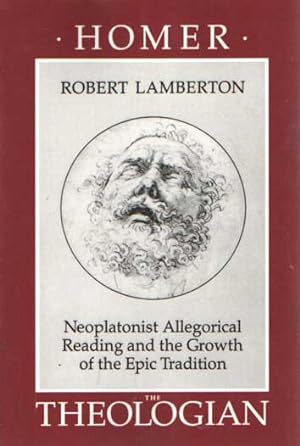
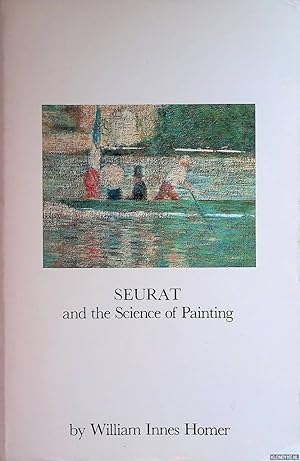
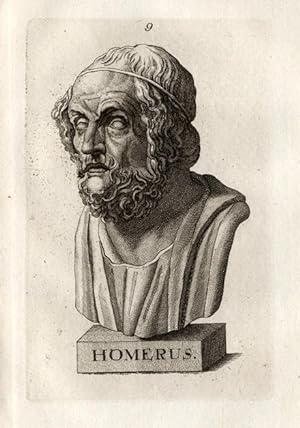
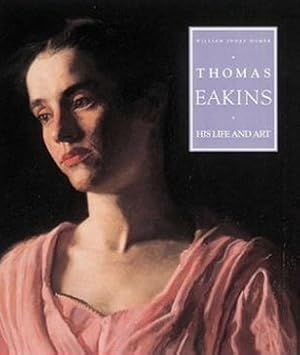
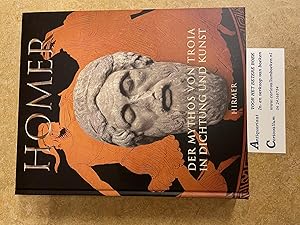
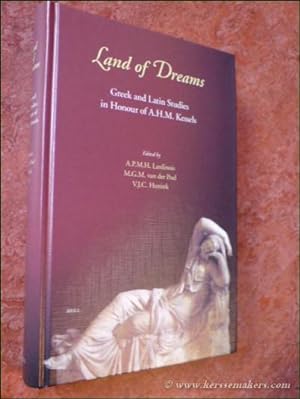
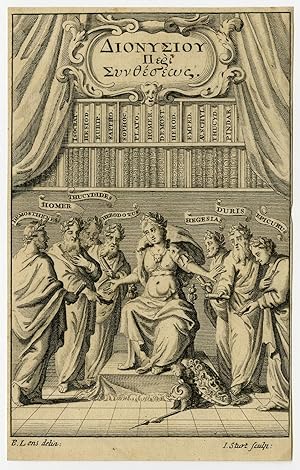
![Seller image for [Antique print, etching and engraving] Portrait of Dutch jurist/lawyer Boetivs ("Boetius", 1529-1599), EPO I.C., pulished 1680, 1 p. for sale by Antiquariaat Arine van der Steur / ILAB](https://pictures.abebooks.com/inventory/md/md22497829566.jpg)

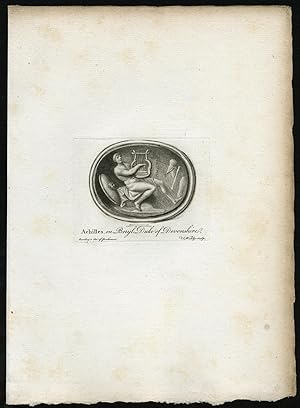
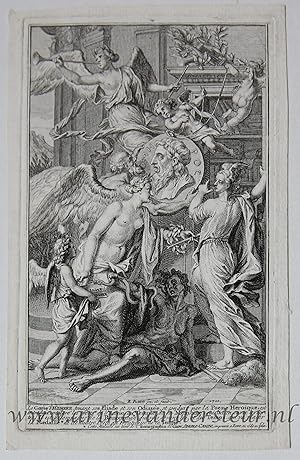
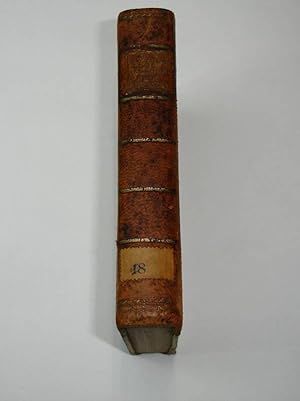
![Seller image for Homers Iliade. Erklärt von J. U. Faesi, I-IV. Gesang I-XXIV. Sammlung griechischer und lateinischer Schriftsteller mit deutschen Anmerkungen. [FOUR VOLUMES]. for sale by Librarium of The Hague](https://pictures.abebooks.com/inventory/md/md17304219095.jpg)
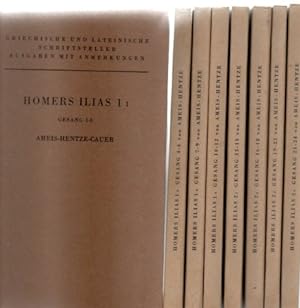
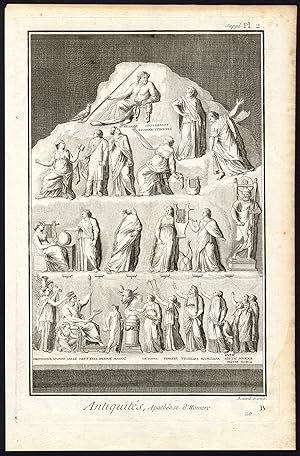
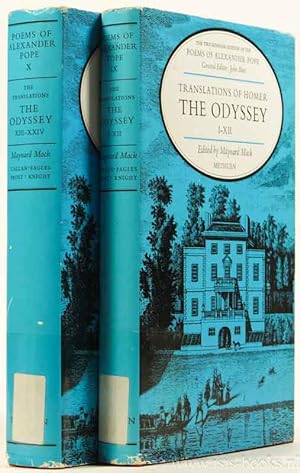
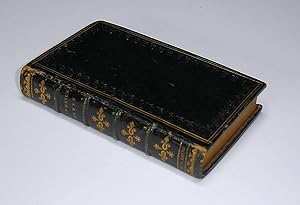
![Seller image for De kleine Telemachus, of kort begrip van de lotgevallen van Telemachus, zoon van Ulysses [Homer] for sale by Goltzius](https://pictures.abebooks.com/inventory/md/md30694850009.jpg)

